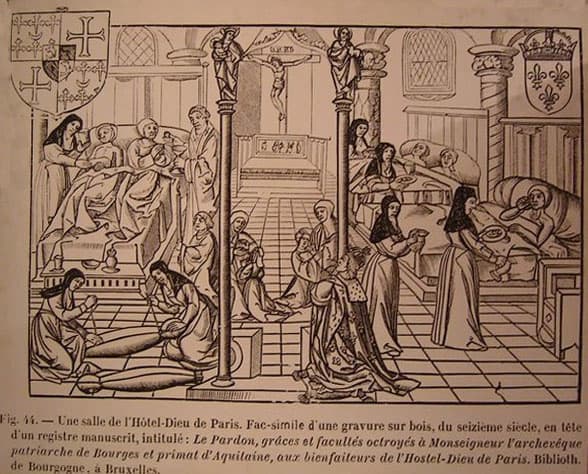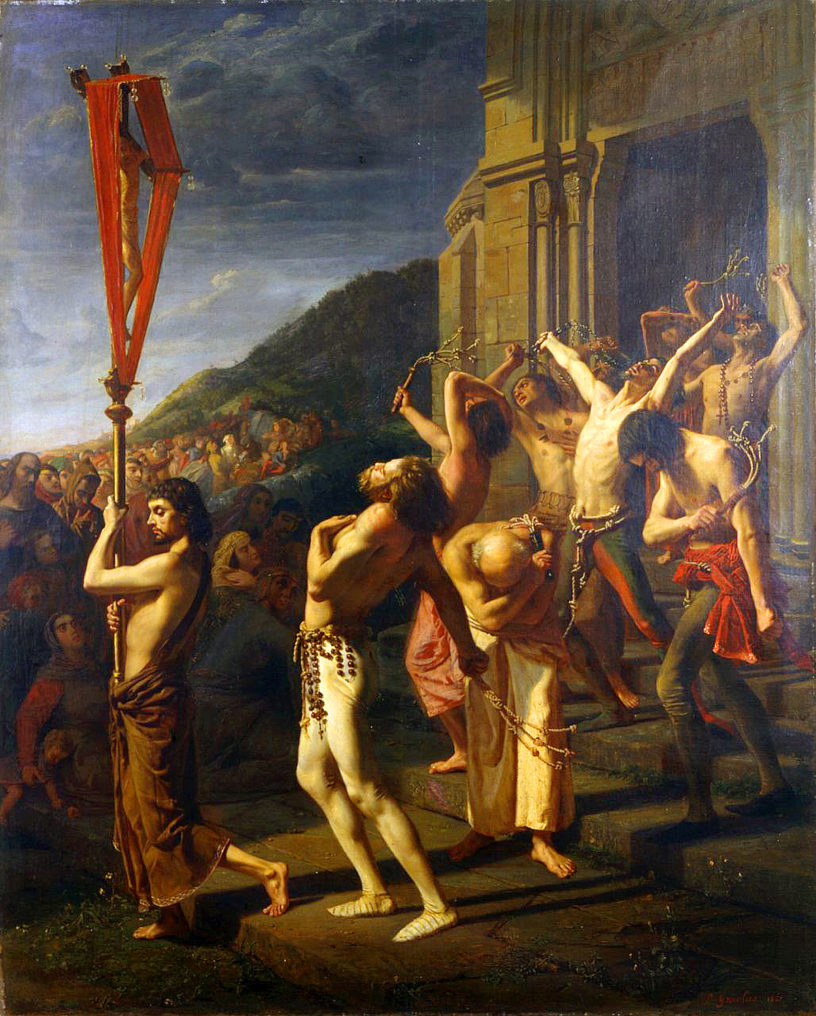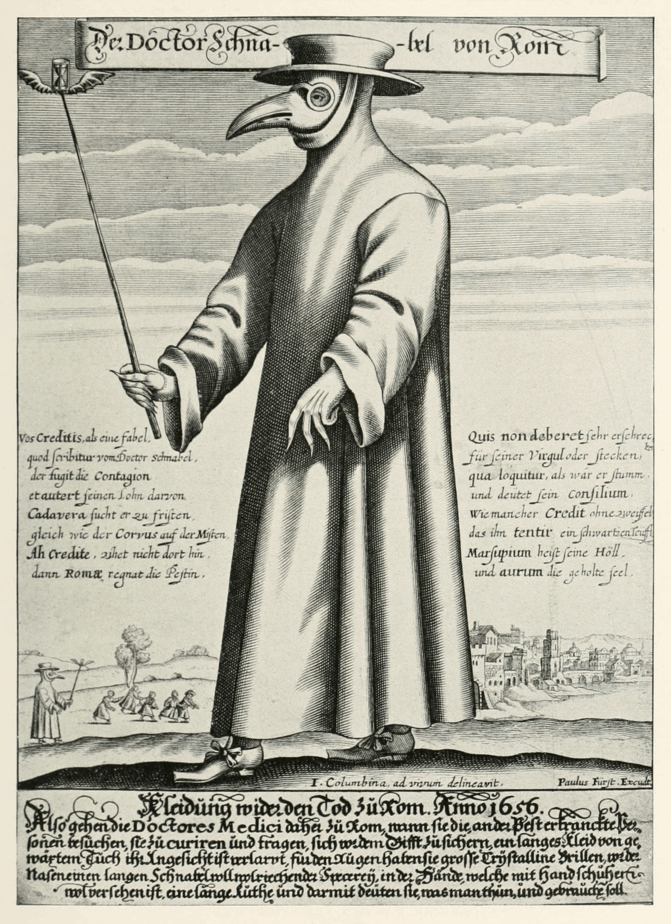7 facts about the Black Death of 1348 in Paris
From 1348 to 1350, in Paris, there was not enough living to bury the dead. This sentence, which is not an exaggeration, summarizes the incredible catastrophe that struck Paris with the rest of Europe with this epidemic of plague.
It was unprecedented and remains the deadliest epidemic in Paris in proportion of the population. One can only imagine the consequences of a nuclear war to get an event of similar proportions.
Coming from Asia and spreading through trade and wars, it made 25 million of victims, which was about 40% of the European population.
To give some context, France and England were at the beginning of the Hundred Years War which had not greatly affected Paris so far. The city had grown fast in the last centuries, it was juste after the prosperous time of the cathedrals.
By focusing on Paris, we can understand better what it could mean to live in the city in such a time. Here are 10 facts about the Black Death of 1348-1350 in the city.
1. Paris was very vulnerable to the plague
Before the epidemic, Paris was the most populated city of western Europe.
Yet it was small in size, limited by the city walls built in 1200 even if the city had started to grow outside of them. This means that this population was crammed in little, narrow streets, with 4 or 5 story buildings.
The conditions of hygiene were bad: there was no sewer and no bins. The waste, some leftovers of the many food markets often remained in the streets which attracted a lot of rats.
Important parts of the population were in poverty, struggling to find food. Ignorant about the principles of good nutrition, even the rich had lot of deficiencies, which left their bodies very vulnerable.
Taken into account child mortality, life expectancy was around 18 years old even if some could reach a very advanced age.
All these characteristics explain for the vulnerability of the Parisians to this disease transmitted by the fleas of the rats.
2. The plague killed a third of the inhabitants
The plague reached Paris through Normandy in August 1348.
It developed in the city, changed, reach a last peak of mortality in 1349 before a sudden decline.
It is estimated that there was around 200 000 inhabitants at that time. At the end of the epidemics, between 50 000 and 80 000 Parisians had been killed, that is around 1/3 of the population.
In the parish of the church Saint-Germain L’Auxerrois, for which documented date are available, the mortality rate was 50 times higher than usual.
Paris took about two centuries to recover its population before the epidemic. And this is rather quick compared to the rest of France, that had come back to the levels of the Antiquity and recovered it only around the Revolution in the late XVIIIth century.
3. There was two kinds of plague
The plague was not called the Black Death before the XIXth century.
It manifested in two different shapes: the bubonic plague and the pneumonic plague.
The first one is the most famous. The bubonic plague stayed in the memories because it was more spectacular with the buboes. The symptoms were abdominal pains, fevers that could be accompanied with nausea and vomiting and a general feeling of weakness.
Buboes, that are swollen and painful lymph nodes, would appear under the arms. The area around the flea’s bite would turn black as the skin’s cell died. It was deadly in 40% of the cases.
The plague became even more dangerous when it became the pneumonic plague. It means that the bacteria were in the lungs and could spread easily to others persons through coughing. There was no hope of recovery for this disease: in 3 days on average the sick was killed.
Even if the way the disease propagated was misunderstood, it was known that the presence of the sick was contaminating. As a consequence, the dying would sometimes see everybody running away from them and died alone, without any help or consolation.
Before revealing itself, the disease could incubate for several days. If you were in close contact with someone the days before the symptoms appeared, it was probably too late.
The situation created an understandable panic and a research for answers.
4. The plague was considered a divine punishment
Religion was everywhere in medieval mentalities.
Many events were interpreted as the revelation of the divine wills. Rational explanations could be considered but not automatically and not by everybody.
The Christians already lived in a feeling of guilt, with the idea that humans were sinners since the Genesis. Thus, it is normal that the plague has been seen as a consequence of the sins of men who would feel the wrath of God.
The panic created massive demonstration of faiths, a renewal of religious intensity. People often addressed their prayers to the Virgin Mary. Several saints, with unclear links to the plague like Saint Sebastian, were also worshipped.
There was a lot of processions starting from the churches like the newly built Notre-Dame. In all Europe, these processions started to get out of the hands of the religious authorities. Crowds of panicked men and women called the flagellants started to whip themselves publicly. The superstitions arose and scenes of collective hysteria were seen.
In this context, it is not a surprise that the population looked for scapegoats. Some Jews were accused of having poisoned the wells. The lepers and many isolated persons were also accused.
The pope had to strictly condemn flagellants’ processions before the movement decreased.
5. The University of Paris accused the contamination of the air
The king of France Philippe VI turned to the most knowledgeable experts of his time for answers. These experts were the members of the University of Paris and its prestigious colleges like la Sorbonne.
The University of Paris was nothing like a modern university. It was a federation of schools, the colleges, made to train religious clerks and officials. It incorporated several faculties including the faculty of medicine.
Knowing this, we understand that in no way, it was a place for a secular science relying on experimentation. It was a religious institution where knowledge was included in a religious understanding of the world and limited by it.
These experts affirmed that the plague was linked to a contamination of the air. Their answers quoted Aristotle, and the great philosopher of the XIIIth century Master Albert.
Their answer was also based on astrological observations as the movement of the planets and the stars was thought to have important consequences.
The special conjunction between Mars, Jupiter and Saturn was interpreted as unfavorable. The observation of a comet 3 years before the start of the epidemic was also considered as a bad omen.
They strictly rejected the idea of contagion. Of course, there was no way to observe the microbes and to understand the process at stake, but this idea of contagion was nonetheless believed by many ordinary people, based on their daily observations. Common sense was in this case less misleading than years of studies.
The theory of the contaminated air is the reason why the physicians wore long noses full of smelling herbs.
They would often prescribe the same herbs or vinegar baths, among other fanciful remedies, to the sick.
What they did not know is that their uniform made to protect their whole body from this contaminated air, protected them from the fleas. They had done the right thing for wrong reasons.
6. The Church suffered a lot during the Plague
The city was not adapted to face an epidemic of this size. The situation was aggravated because all the people who could leave the city did it. The richest and most dynamic part of the population took shelter in the countryside.
Remained mostly the poor who had to continue working and many religious whose duty was to stay.
These priests, monks and nuns who did the religious offices and took care of the sick paid a very high price.
These losses caused a major problem because of the importance of the confession in Catholicism. Most people were scared to go to hell if they did not receive the absolution of their sins and crimes. It became increasingly difficult to find a priest available and willing to visit people affected by the plague.
The staff of the hospital was also composed of religious. At this time the only hospital of Paris was l’Hotel-Dieu, literally meaning the House of God.
It was located 50 meters from Notre-Dame, by the river Seine. The hospital still exists but has been slightly moved in the middle of the island with buildings from the XIXth century.
Very different from a modern hospital, it was rather a charity, where nuns took care of the sick and the poor. Already before the plague, it was overcrowded with several people sharing the same beds. The mortality rate, once a sick got inside, was 20%. This mortality skyrocketed during the plague.

Engraving representing the Hotel Dieu in the 16th century: it was very similar in 1348. Sourced from Wikipedia
Jean de Venette, Parisian monk and witness of the events, wrote that the teams of courageous nuns had to be renewed several times. He described carts coming to take 500 corpses every day.
One of the bells of Notre-Dame, the knell, rang for every death signalled, creating a very morbid atmosphere in the city.
7. Burial practices had to be changed
The boats which would usually bring bread to the capital were requisitioned to help moving the corpses. Coming from the city of Corbeil, the received the nickname of “Corbillard”, which is still today the French word for “hearse”.
The cemeteries also had problems. There were many little cemeteries next to the churches but the biggest one by far was called the Cimetière des Innocents, near from what is today the mall Les Halles, in the center of the city. It was for instance the cemeteries used for people who died in the Hotel-Dieu.
Quickly, it was not possible to bury people individually like for a proper Christian burial. There was not enough time, not enough space in the cemetery, and not enough surviving dig-gravers.
The authorities decided to create mass graves. They opened big holes in the cemeteries, blessed and piled the bodies as respectfully as it was possible and then close the holes.
Even with this system, the Cimetière des Innocents was too small and a new cemeterie opened: the Cimetière de la Charité.
The cemetery was closed in the XIXth and the bodies removed but it turned out that some had been forgotten. In 2014, during works in the underground of a supermarket, the bodies of 200 victims of the plague were found.
The plague progressively decreased and disappeared in 1350. It is possible that the bodies started to adapt or that the rules made to control the movements in and out of the city were useful. Changes in the population of the rats, less fragile grey rats replacing black rats is another theory.
The economy of the city was dramatically changed. Renting prices were divided by 4. Workers became rare, which made the wages go up. However, war continued against England despite huge losses suffered by the two countries.
***
The plague came back in the following decades and centuries but never caused a disaster of similar proportions.The bodies of humans and rats adapted better, the reaction of the authorities became more efficient.
It is possible to day to find the traces of the plague. The cemeteries of Paris were all emptied between the end of the 18th and the mid 19th century and put in underground galleries today known as the Catacombs.
Some of the skulls looking at you are these victims of the biggest epidemic of the history of Paris.
Planning a trip to Paris ? Get ready !
These are Amazon’s best-selling travel products that you may need for coming to Paris.
Bookstore
- The best travel book : Rick Steves – Paris 2023 – Learn more here
- Fodor’s Paris 2024 – Learn more here
Travel Gear
- Venture Pal Lightweight Backpack – Learn more here
- Samsonite Winfield 2 28″ Luggage – Learn more here
- Swig Savvy’s Stainless Steel Insulated Water Bottle – Learn more here
Check Amazon’s best-seller list for the most popular travel accessories. We sometimes read this list just to find out what new travel products people are buying.















